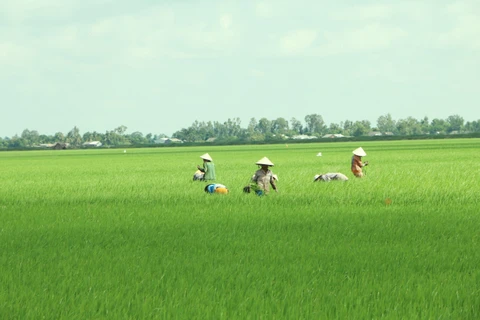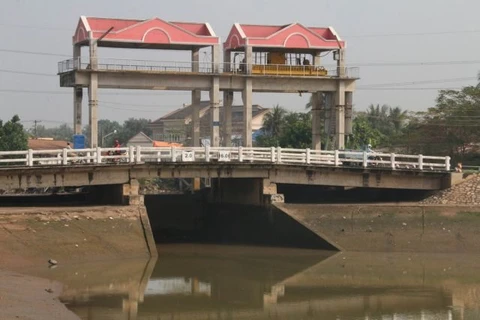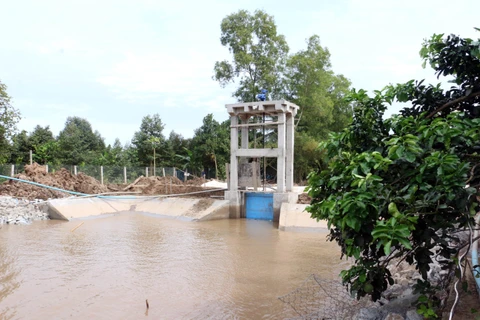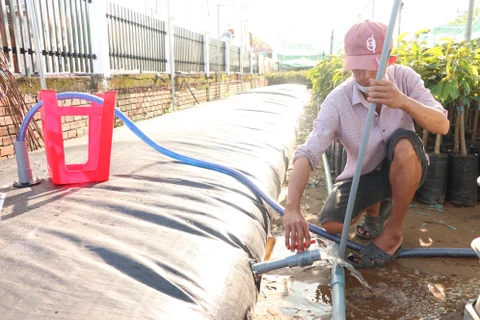 A map shows saltwater intrusion predictions for the southern region (Source: Vietnam Meteorological and Hydrological Administration)
A map shows saltwater intrusion predictions for the southern region (Source: Vietnam Meteorological and Hydrological Administration) Hanoi (VNA) – For the remaining time of the 2020 dry season, saltwater intrusion in the Mekong Delta is predicted to continue and increase amid tidal surges as the rainy season in the southern region comes late, widespread heat waves have begun to occur, and the Mekong River’s flows to the biggest rice production hub of Vietnam continue to fall.
Serious saltwater intrusion
According to the National Centre for Hydro-Meteorological Forecasting, there have been almost no rains in the Mekong Delta since early February while heat waves with temperatures of over 35 degrees Celsius have been recorded in some areas, leading to stronger tidal surges and saline encroachment into local river mouths.
At present, water levels on the mainstream Mekong River are 0.1 – 0.8 metre lower than the average and the same period of 2016, when historic drought and saltwater intrusion were reported. Seawater encroachment in this region rebounded on February 19 and 20.
Besides, the water level on Tonle Sap Lake of Cambodia is also low, making it hard for this lake to supply more water for the Mekong Delta. As a result, water intrusion in the Mekong Delta is likely to become more severe compared to previous years.
Given this, the National Centre for Hydro-Meteorological Forecasting projected that the Mekong River’s water flows to the region will be 5 – 20 percent less than the average and in 2016. The salinity rate of 4 grammes per litre will encroach 25 – 35km deeper into the mainland compared to the average.
[Sinking predicted for Mekong Delta region]
At certain points of time, saltwater intrusion may be equivalent to or more serious than the level in the same period of 2016. Therefore, during the rest of the 2020 dry season, seawater invasion is likely to continue and get worse amid tidal surges.
Particularly, in late February (from February 21 to 27), seawater is forecast to invade about 45 – 52km deep into the Cua Tieu and Cua Dai Rivers, 65 – 76km into the Ham Luong River, and 55 – 62km into the Co Chien River.
The phenomenon will increase on the Mekong River in March. From March 6 to 15, it is likely to be equivalent to or more serious than the intrusion in mid-February. It will remain high on the Vam Co and Cai Lon Rivers from late March to April and then gradually abate.
If the rain shortage lingers and the exploitation of water resources in the river’s basin (including the use of water on the Mekong River’s branches and water storage by hydropower dams) rises, drought, water scarcity and saltwater intrusion will prolong and become more severe than in the 2015 – 2016 dry season, the National Centre for Hydro-Meteorological Forecasting warned.
Proactive response needed
Facing growing saltwater encroachment in the Mekong Delta, hydro-meteorological experts urged localities in the region to continue taking proactive response actions and have detailed assessments of local water resources so as to issue appropriate solutions.
[Localities asked to stay active in coping with water scarcity]
Additionally, all-level authorities and people need to stay updated with forecasts and warnings. Locals should also proactively store, save and use water efficiently so as to minimise water losses. Administrations in disaster-hit areas have to boost communications to raise both cadres and people’s awareness of natural disasters, drought and response measures.
 At certain points of time, saltwater intrusion in the Mekong Delta may be equivalent to or more serious than the same period of 2016.
At certain points of time, saltwater intrusion in the Mekong Delta may be equivalent to or more serious than the same period of 2016. On January 22, Prime Minister Nguyen Xuan Phuc issued Directive 04/CT-TTg on the implementation of solutions to drought, water scarcity and saltwater intrusion. Deputy Prime Minister Trinh Dinh Dung recently also chaired a conference in Ben Tre province to seek ways to cope with drought and seawater invasion so as to ensure agricultural production and people’s lives in the region during the 2019 – 2020 dry season.
The Ministry of Agriculture and Rural Development has coordinated with localities to speed up anti-saline encroachment projects. Some of them have been put into temporary operation, including the Au Ninh Quoi sluice, the Xuan Hoa pumping station, the Nam Mang Thit irrigation system, 18 salinity control sluices in the first phase of the Bac Ben Tre project, and the May Phop – Nga Hau canal dredging project.
Those facilities have directly controlled saltwater intrusion for about 83,000ha of land and helped mitigate its impact on another 300,000ha.
In the long term, experts recommended localities install automatic salinity monitoring devices so as to stay updated with the situation and actively carry out suitable response measures for each period. They should also prioritise resources for perfecting existing irrigation systems and dredging canals to control tides and saltwater encroachment.
Localities in the Mekong Delta also need to step up crop restructuring, especially in the areas vulnerable to drought, water scarcity and saltwater intrusion, in order to have more diverse farm produce like aquatic products, fruits and rice to meet the market demand./.

























